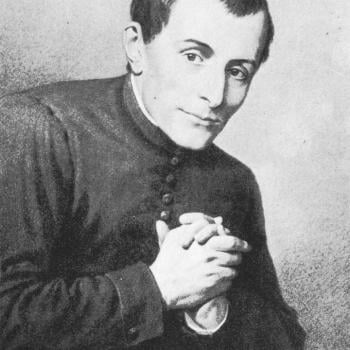The Jesus prayer is the simple prayer, “Κύριε Ιησού Χριστέ, Υιέ του Θεού, ελέησόν με, translated: “Lord Jesus Christ Son of God have mercy on me.”[1] It is one of the central prayers of the Eastern Christian traditions. It forms the primary practice encouraged in The Philokalia, a monumental and massively popular book in the Eastern Orthodox tradition.[2] Many have wondered why such a simple prayer has become such a central part of the Orthodox spirituality. The power of the Jesus Prayer lies in the truth that it aims to transform the heart, and that the heart is the seat of the human person from which the spirit seeks to bring transformation to the whole person, and through them the world.
Where does the Jesus prayer come from?
The Jesus Prayer in its current form seems to have come from the Desert Fathers. The earliest reference we have to the Jesus prayer is in the Discourse on Abba Philimon, from the 6th century[3]. Inscriptions of the prayer was also found on the wall of a monk’s cell dated to approximately the same time of the Desert Fathers.[4]
The Jesus Prayer appears to have come out of a early tradition of Desert Fathers and Mothers where they would say their private prayers in the form of short aspirations.[5] These might be passages from scripture, or the name of Jesus. This led to an interaction with certain key passages in scripture that began to form the Jesus prayer. Chief among these passages of scripture, from which the monks seemed to have gleaned the Jesus prayer is Mark 10:47. In this passage a blind man calls out to the Lord, “Jesus, thou son of David, have mercy on me.” Luke 18:13 is also influential; in this passage a tax collector beats upon his breast and says, “God be merciful to me a sinner.” As the prayer has continued to evolve, some have found inspiration in Matthew 16:16 where Peter declares of Jesus, “Thou art the Christ, the Son of the living God.”
Today the Jesus Prayer has many variations from its “traditional” form. It is sometimes recited as simply as “Jesus mercy”, or as long as “Lord Jesus Christ Son of the living God have mercy on me, a sinner.” At times people have found it powerful to say “have mercy on US” rather than “have mercy on ME.” This reflects a flexibility that goes back to the heart of where the prayer came from. The Jesus Prayer did not come out of a rigid formalism, but from the living faith of a community set on sharing life with God.
The Power of the Jesus Prayer
The power of the Jesus prayer is rooted in a conviction that God’s presence is transformative. When people are around God they are changed. Just as Moses’ face shone after he entered God’s presence at mount Sinai (Exodus 34:35), so too, we are changed and begin to take on the life of God. However, how can we, who are finite, come to a place where the transformative energies of God will come in contact with us?
Orthodox theologians believe that the Name of God is a place where God is present. This theology comes from reflecting on the many passages that deal with the power of the name of God in scripture. The reign of God in the world is described in Micah 4:5 as people walking in God’s name. An invocation of God’s name on a people makes them belong to God in Genesis 48:16 , Deutoronomy 28:10, and Amos 9:12. There is a sense in which the name of God, just like the word of God (or logos), reveals the very person of God. Philippians 2:9-10 tells us that Jesus has been given God’s own name, and that at the name of Jesus every knee shall bow. Invoking the name of Jesus is more than a cognitive devotional practice it is a declaration that reveals the victory of God over sin in the person of Jesus Christ.
The call of humans to bear the name of Jesus
The Jesus prayer is more than just a prayer; when done in accordance with the teachings of the church fathers it becomes a way of life, and a vehicle for the Holy Spirit. It is a little phrase that becomes a catalyst to change the one who undertakes it to the very core, this is why it is so powerful. It has the ability to change a human being into a servant of God.
But why would God choose US to bear His Name to the world? At the heart of the Christian message is the conviction that God has chosen to save the world through human beings. In the person of Jesus Christ, God joined humanity: lived, died and rose again. God assumed all our brokenness and called all of creation to enter into His wholeness. Incredibly God continues to save the world through humanity. Through His church God calls people into Christ’s death and guides them into the new life of resurrection. Christians are people with a powerful mission: save the world.
Leo Tolstoy once wrote, “Everybody thinks of changing humanity and nobody thinks of changing himself.”[6] I really like this quote because it highlights one of the great paradoxes of the Christian faith. God is changing the entire universe by transforming individual people. The kingdom of God is ushered in one man and women at a time.
At the heart of this individual transformation is what the church calls spiritual disciplines. Spiritual disciplines are the paths that help bring individuals into a life of communion with God. These seemingly simple patterns of life hold in them the power to change the world. Regular scripture reading forms the intellect into the patterns of God’s Kingdom, a regiment of fasting brings the body under the lordship of the Holy Spirit, Participation in the liturgy can create channels of worship in the sub-conscience. The Jesus prayer works to bring the whole person into submission to the work of the Holy Spirit in the heart of an individual. This is why the Jesus prayer is sometimes called “the prayer of the heart.”[7]
How to Pray the Jesus Prayer
When I first encountered the Jesus prayer I was drawn to its simplicity, and later realized the depth of its power. I included it among many other prayers that I had learned and had a special fondness for it, however, I didn’t experience a great deal of change in my life because of it. I wondered how it was that it was seen as so important to so many Fathers of the church, but seemed too trite to me. Upon examining the issue further I learned that for the Jesus prayer to have the greatest power in a person’s life it should be done in a particular way, and should be done to achieve two things: ceaseless prayer and stillness (Hesychia).
Ceaseless Prayer
In 1 Thessalonians 5:17 there is a simple command, “Pray constantly.” Although this verse is one of the shortest in the whole of Sacred Scripture, it is one of the most difficult commands to follow. How is one to pray without ceasing? We are humans who need to eat and sleep, are we not? This question is the question that plagues the mind of a anonymous pilgrim in the 19th Century spiritual classic, The Way of the Pilgrim.[8] In the novel the pilgrim eventually discovers the secret to ceaseless prayer, after months of fruitless searching, when he happens upon a monk from Mount Athos who shows him the Jesus Prayer.[9] The pilgrim uses a rope with knots to count how many times he has prayed the prayer and prays the prayer over and over hundreds and hundreds of times a day. Soon it becomes something natural that repeats in his heart as he goes about his day. Even in the midst of the daily routines of life the pilgrim finds himself in prayer.
The advice given in The Way of the Pilgrim. is consistent with the prescription of the Eastern Churches for hundreds of years. Kallistos, patriarch of Constantinople, once wrote, “Unceasing prayer consists in an unceasing invocation of the name of God. Whether talking, sitting, walking, making something, eating, or occupied in some other way.”[10] Even earlier in the writings of the Desert Fathers we find that Macarius of Egypt taught that by constantly ruminating on the name of Jesus, like chewing on gum, people will find salvation.[11]
My own attempts to find ceaseless prayer in this manner have not met with perfect success. I have not yet found myself refreshed by the name of Jesus at all times, and in the midst of all activities in my life. However, I have found a good deal of change in my life as I have tried. After reading The Way of the Pilgrim I began to use prayer beads to say the Jesus Prayer a few hundred times every once in a while. I also began to keep prayer beads or a prayer rope in my pocket. This way I was reminded to pray throughout the day and had a tool with me at all times to help facilitate prayer. Through these simple steps I have personally found a great deal of peace, and my heart more consistently set on Christ.
Hesychia
Hesychia is the second thing practitioners of the Jesus prayer seek to achieve. It is a Greek word for “rest”[12] that has come to have great significance in the Eastern Christian traditions. It is a way to pray though which the one who prays goes on a journey, through inner stillness and silence, into their heart. Hesychists believe Jesus, when He says, “The Kingdom is within you” (Luke 17:21), and they seek to find it.[13] Hesychia is the way that many Eastern Christians have found to follow the command of Jesus to, “go into your closet” to pray (Matthew 6:6). It is in this space of silence that people find there is more than a negation of sound, but “an attitude of attentive alertness, of vigilance, and above all of listening.”[14] One of the most common ways this stillness is achieved in the Eastern Churches is though the Jesus Prayer.
The ancient desert fathers viewed hesychia as their natural habitat, they viewed their cells as places of silence and would return to them as much as they could to enter into the stillness of prayer. This constant state of prayer was so important to early desert monastics that on one occasion one of the fathers compared a monk outside of their cell to a fish out of water.[15] Although most people do not have the ability to follow in the rigor of the hesychists masters, there is still a good deal to learn in this practice and the Jesus Prayer is a powerful tool to achieve hesychia. Unlike ceaseless prayer, which is rooted in prayer within the day to day rituals and concerns with life, this effect of the Jesus Prayer is strengthened from taking time out of the day to day rituals and concerns of life, and spending time in devoted prayer with God.
One of the common ways to use the Jesus Prayer to foster stillness is done by finding a quiet place to sit and close your eyes. This removes the distractions from all around you. Begin to repeat the Jesus Prayer over and over. Some have found it helpful to let the head rest on the chest while sitting upright. This is a simple posture that can help reflect the hoped for goal of bringing the mind into the heart. The mind naturally grabs hold of images and thoughts, let these pass without taking hold of them. Praying the Jesus Prayer is similar to watching clouds pass by. Thoughts like clouds will come, but let them drift on without focusing on them, return your mind to the task at hand: entering the heart. Saint Theophan the Recluse names three stages of prayer that one enters into: first is the oral prayer where there is simple recitation, but the prayer remains an external prayer apart from the practitioner. This is sometimes called the “prayer of the lips.” Second, there is the stage of “focused prayer.” In this stage the mind becomes focused upon the words of the prayer. The prayer becomes the prayer of the prayer themselves. Thirdly, there is the prayer of the heart. In this stage the prayer is no longer something we do but who we are.[16]
Some Tools to help
The church, in its wisdom, has passed on a number of tools to help people along the way as they pray this prayer. We have touched on some of these tools already, but will expound on them more here. Hopefully these tools can be incorporated in the appropriate ways in your own prayer life so that the Jesus Prayerwill help you to live more completely as the person God has called and created you to be.
- A “spiritual father”One of the most important things tools to have when praying the Jesus Prayer is a “spiritual father”. This is someone who can help give you direction in the process. The Jesus Prayer has many pitfalls people can fall into. People can become more concerned with achieving feats of spiritual athleticism rather than praying. A spiritual father (or mother) can help direct how you should pray the Jesus prayer and what other tools might be helpful in this process.
- A prayer rope
We have already mentioned this tool a little bit. There are many ways in which you can use a prayer rope. I mentioned that mine helps me remember to pray by being in my pocket. Prayer ropes can also help you count the number of prayers you have done. Many prayer ropes will have 100 knots on them so that when you make it all the way around you can keep track of how many prayers you have said. This is important if you have taken on a particular prayer practice of praying a set number of prayers in a day, or at a given time.[17] A prayer rope can also act as a tool to keep the mind from following other thoughts. The knots or beads in your fingers offer a reminder of where you mind should be, just like the words of the prayer are used to draw a the prayer back into the awareness of God. - Breathing exercisesBreathing is another tool that has been traditionally used in the Jesus prayer. One can create a rhythm of prayer along with the breaths that they take. Often the first part, ‘Lord Jesus Christ, Son of God’, is said while inhaling, and the second part, ‘have mercy on me a sinner’, while exhaling.[18] There are also those who argue for alternating inhaling and exhaling on every word. Any way you breathe in and out this technique is designed to help you bring the mind into the heart just as air flows next to it in breathing in. This focus on the location of the heart is why some people also say the prayer in rhythm with the heart. It is highly recommended that this is done under the guidance of a spiritual father or mother.[19]
- A good location and postureHow and where you pray are also quite important. Finding a spot where you can pray free of distraction is one thing that can be done to assure that there will be less distractions to take hold of the mind. There are also certain postures that are recommended:
- St Gregory of Sinai places an emphasis on posture when engaging in prayer to achieve hesychia. He suggests
- sitting on a low stool, about nine inches high;
- the head and shoulders should be bowed,
- the eyes fixed on the place of the heart. [20]
- Others have recommended the head should be held between the knees, following the example of Elijah on Mount Carmel[21]
The Words of The Prayer
The actual words of the prayer in their simplicity have a treasure of deep meaning. Exploring the great depth of each word is far beyond the scope of this small guide. However a brief look at each word in the prayer will prove a good start.
Κύριε / Lord
The word “Lord” is loaded with meaning. Many times in our own Bibles it is used as a replacement for the Holy Name of God יהוה. The word in Greek means “master” or “Lord” or “owner.”[22] This word is a declaration of who we are in relationship to Christ. We are servants and slaves to the Lord and Master.
Ιησού / Jesus:
As we mentioned before the name of Jesus is the name by which every knee will bow. It is a testimony of the mystery of the incarnation. Jesus was given this name when He become incarnate, and took on flesh. This word is a testimony to the humanity of Christ. We remember here that it is because God became man that man is able to find transformation in the presence of God.
Χριστέ / Christ:
This word comes from the word מָשִׁיחַ which means anointed. In this word is an affirmation that God has chosen the person of Jesus to save His people to bless the whole world. It reminds us of who we are in Christ, and our mission to heal the world.
Υιέ του Θεού / Son of God:
Although this is not a single word, it is a unified concept. Since the days of the early church this phrase has been a confessional title[23] for who Jesus is in the Trinity. It reminds of Jesus’ special relationship within the Trinity, and our special relationship to God through Him.
ελέησόν / Have Mercy:
Although many westerners think of mercy in judicial terms. In the east, where this prayer has taken root, Mercy has more of a holistic understanding. It means means God’s love poured out to heal. This word is a prayer of hope. It seeks that Christ Jesus will make everything right, and testifies that we can not.
με / On Me:
By declaring that we are in need of mercy we give up the right to make any claim on God[24], for the one who asks for mercy has no claim on the one to whom they ask. This word is a testimony of humility. We declare that God is greater than we are.
As you pray the Jesus Prayer be aware of where you place emphasis. In The Way of The Pilgrim the pilgrim is told that the phrases that are focused on can teach a person a great deal on where the Holy Spirit is moving in the heart of the one who prays. For example if one places emphases on the phrase “Lord Jesus” it could show the Holy Spirit is moving them to faith in the divinity of Jesus. If they pray with fever at the words “have mercy” it could show a movement toward humility.[25]
Conclusion
The Jesus Prayer has a unique power to transform the heart through the working of the Holy Spirit. Out of this practice many have been transformed, and become salt and light to creation. With the great power of the name of Jesus comes a great responsibility to follow after the example of Christ for the life of the whole world. I pray that this short guide has helped in some way to instruct you in this little prayer, and may lead you to a greater life in communion with Christ and the work of His church
[1]Kadloubovsky, E., and G. E. H. Palmer. Writings from the Philokalia on prayer of the heart; . (London: Faber and Faber, 1951), 74.
[2]Chamberas, Peter A..Nicodemos of the Holy Mountain: a handbook of spiritual counsel.( New York: Paulist Press, 1989), 21.
[3]Gillet, Lev. The Jesus Prayer . Rev. ed. (Crestwood, N.Y.: St. Vladimir’s Seminary Press, 1987), 38.
[4]Guillaumont, Antoine. 1974. “Jesus prayer among the monks of Egypt.” Eastern Churches Review 6, no. 1: 66-71.
[5]Ibid, 31.
[6]Tolstoy, Leo. Pamphlets. Translated from the Russian . (Christchurch, Hants.: Free Age Press, 1900), 71.
[7]Funk, Mary Margaret. Tools matter for practicing the spiritual life . (New York: Continuum, 2001), 93.
[8]Savin, Olga, tr. The way of a pilgrim . (Boston: Shambhala, 2001),1.
[9]Ibid, 120.
[10]Brianchaninov, Ignatius. On the prayer of Jesus . (Boston, Mass.: New Seeds, 2006), 62.
[11]Harmless, William. Desert Christians an introduction to the literature of early monasticism.. (New York: Oxford University Press, 2004), 220.
[12]Plante, Thomas G..Contemplative practices in action: spirituality, meditation, and health. (Santa Barbara, Calif.: Praeger, 2010), 63.
[13]Ware, Kallistos. The Inner Kingdom . (Crestwood, NY: St. Vladimir’s Seminary Press, 2001), 89-93.
[14]Ware, Kallistos. The Power of the Name: the Jesus prayer in Orthodox spirituality. (Oxford: S.L.G. Press, 1986), 3.
[15]Harmless, William. Desert Christians an introduction to the literature of early monasticism. (New York: Oxford University Press, 2004), 228.
[16]Consiglio, Cyprian. Prayer in the cave of the heart: the universal call to contemplation. (Collegeville, Minn.: Liturgical Press, 2010), 87.
[17]Saying a certain number of Jesus Prayers is not always recommended and is often discouraged. It may be wise to talk to a spiritual mentor of some sort before undertaking this kind of practice.
[18]Ware, Kallistos. The Power of the Name: the Jesus prayer in Orthodox spirituality. (Oxford: S.L.G. Press, 1986), 12.
[19]Ibid, 12.
[20]Ibid, 12.
[21]Ibid, 12.
[22]Steele, A. T. Exegetical Study Guide Series: an Expositor’s Field Manual. (S.l.: iUniverse Inc, 2009), 228.
[23]Strauss, Mark L.. Four portraits, one Jesus: an introduction to Jesus and the Gospels. (Grand Rapids, Mich.: Zondervan, 2007), 485.
[24]Ware, Kalistos. The Orthodox Way . New rev. ed. (Crestwood, NY: St. Vladimir’s Seminary Press, 1995), 69.
[25]Savin, 123.













